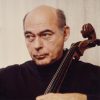Brant Taylor (Chicago Symphony Orchestra) on the cello of his former mentor János Starker.
Brant Taylor: Starker’s Cello, Bridge and Teaching
Cellist Brant Taylor of the Chicago Symphony discusses the history and significance of the cello he plays, which originally belonged to one of his teachers, the renowned cellist Janos Starker. This cello, made in 1977, was primarily used by Starker for teaching demonstrations rather than public performances. After Starker’s passing in 2013, Taylor recognized the cello when it was offered for sale through a Chicago shop and felt compelled to acquire it. Taylor expresses gratitude for being able to play this cello, feeling a connection to his teacher and honoring the legacy of both Starker and the Chicago Symphony Orchestra.
About
RECOMMENDED NEXT
RELATED BLOGS
Conversation with János Starker (February, 2004)
By Tim Janof | 08/05/2019


